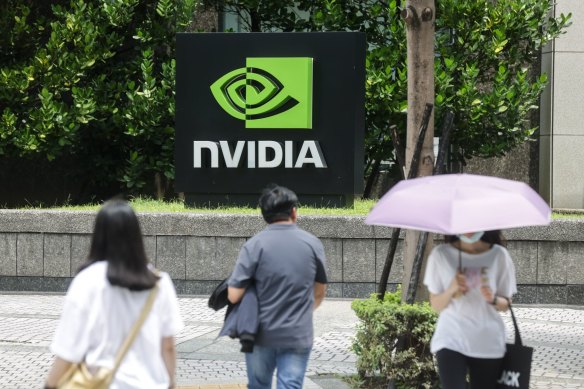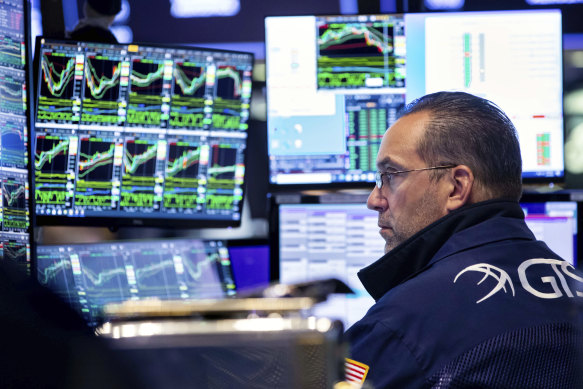Wall Street darling suffers record $416 billion meltdown in one day
September 4, 2024 — 7.24am
Four weeks after US stocks buckled amid a global flight from risk assets, chipmakers set off another bout of equities selling when a pair of industry analysts rekindled worries that the mania surrounding artificial intelligence had gone too far.

Nvidia shares tumbled 9.5 per cent, wiping out $US278.9 billion ($415.5 billion) in the biggest loss of value ever for a US stock. This meant Nvidia’s market capitalisation dropped by the equivalent of the entire value of energy giant Chevron in one day.
The AI giant has slumped by 14 per cent since releasing its results.Credit: Bloomberg
It is now down 14 per cent in the three sessions since it reported earnings that failed to live up to lofty expectations. All 30 members of the Philadelphia Semiconductor Index sank at least 5.4 per cent, with On Semiconductor, KLA and Monolithic Power Systems down more than 9 per cent. The Nasdaq 100 sank almost 3.2 per cent.
Nvidia shares lost another 2 per cent in late trading after the US Justice Department sent subpoenas to it and other companies as it seeks evidence that the chipmaker violated antitrust laws.
Loading
There were other reasons for the bleak start to what is historically a volatile month for stocks. Worries about China’s growth shook commodities markets from oil to copper. US manufacturing data came in light and showed an uptick in prices paid, a potentially worrying sign for inflation hawks. But most catalysing for the tech rout was the fresh warnings that AI’s promise to rewire global economies was far from being realised, making it hard to justify lofty valuations.
That was the gist of views expressed in separate commentaries from JPMorgan Asset Management (JPAM) and BlackRock Investment Institute. Michael Cembalest, chairman of market and investment strategy at JPAM, warned that spending on AI won’t be justified unless demand for AI services from companies outside of tech starts to increase. For Jean Boivin, head of BlackRock Investment, “patience is needed” before AI takes off, a process of “years, not quarters”.
Those warnings, of course, aren’t new. Alphabet shares got hit in July after it reported a spike in AI spending with no promise of a bump in profits, prompting a rotation out of big tech. But the two latest cautions landed in a market that rallied to just short of records in late August, largely on the promise that the US economy won’t crater before the Federal Reserve delivers rate cuts later this month.

“Are we actually going to stick this soft landing, or are we going to get some type of a report later this week that shows unemployment is starting to rise substantially?” said Brian Mulberry, client portfolio manager at Zacks Investment Management. “That’s where you’re starting to see a lot of this volatility coincide, and it’s just hitting the most overvalued sectors first, and people are starting to look for actual earnings growth, real revenues on the balance sheet. And more importantly than anything, really stable forward guidance.”
The Cboe Volatility Index jumped above 20 as the S&P 500 dropped more than 2 per cent, with all but two sectors lower. Like in early August, the selloff spread to other assets. Oil sank 4 per cent and Treasury yields dropped as investors sought havens.
The damage done in the chip sector was extensive, with the Philadelphia semiconductor index dropping the most since March 2020. Intel, whose shares are the second-worst performing in the Philadelphia semiconductor index this year, fell 8.8 per cent. Chip equipment maker Applied Materials fell 7 per cent. Taiwan Semiconductor Manufacturing., the world’s biggest contract manufacturer of chips, dropped roughly the same.
Alphabet, Microsoft and Apple lost at least 1.9 per cent as the pain spread to the biggest tech companies looking to reshape the economy with AI.
The fall was part of a wider tech meltdown on Wall Street.Credit: NYSE
“Outside of the big tech companies buying among themselves, we haven’t really seen AI spread out across the economy,” Paul Nolte, market strategist and senior wealth manager at Murphy & Sylvest Wealth Management, said. “There’s still a big question about the ROI from all this spending. And if you go back to the dot-com era, the first winners of the internet weren’t always the final winners. We’re not yet at a place, in terms of valuations, where I’d want to buy this dip.”
While the August 5 market rout rattled investors around the globe, equities bounced back almost immediately, adding more than 5 per cent through the end of the month. Nvidia itself was among the leaders of that rebound, but as the Fed signalled unequivocally that it intends to cut rates, the rally was especially broad.
Loading
The near-term calendar promises some key economic data releases, especially Friday’s US payrolls report, that will solidify bets on the Fed’s path. But traders will have to wait three weeks for confirmation.
“With equities sharply off the August lows as we enter a well-known period of weak seasonality, and with the first-rate cut widely expected and arguably already priced in, it’s not too surprising to see some de-risking as investors await more data/clarity,” Christopher Jacobson, co-head of derivative strategy at Susquehanna International Group.
Bloomberg
Loading









































